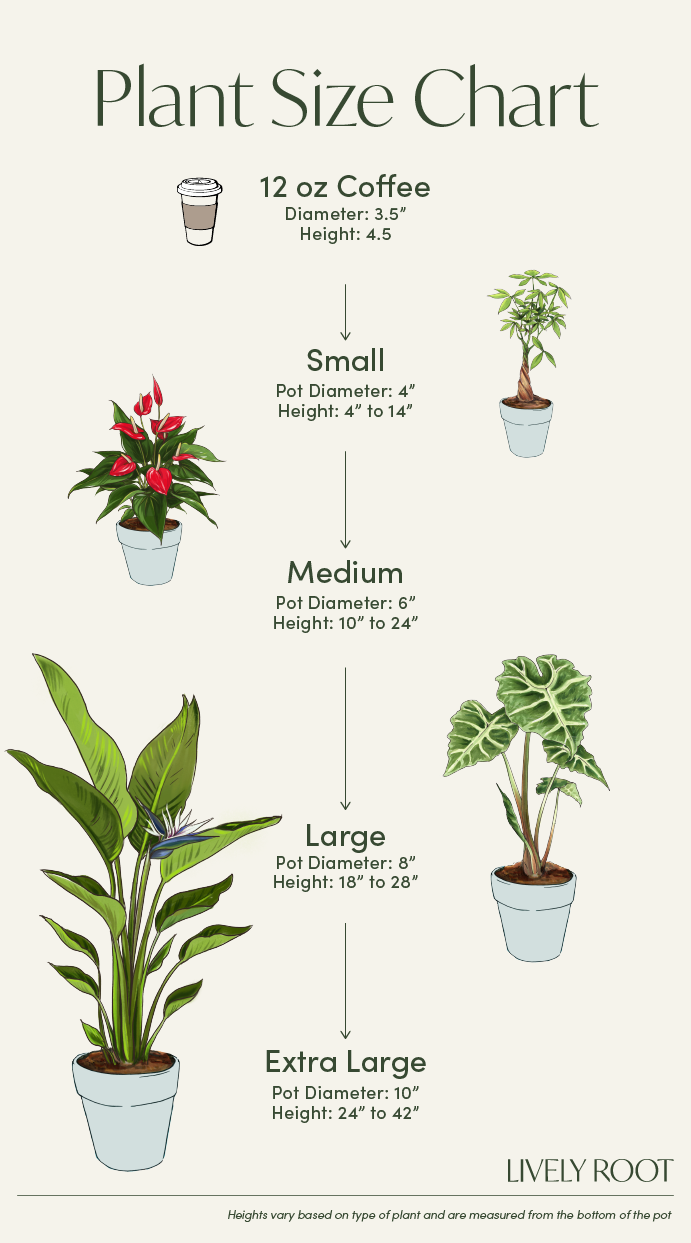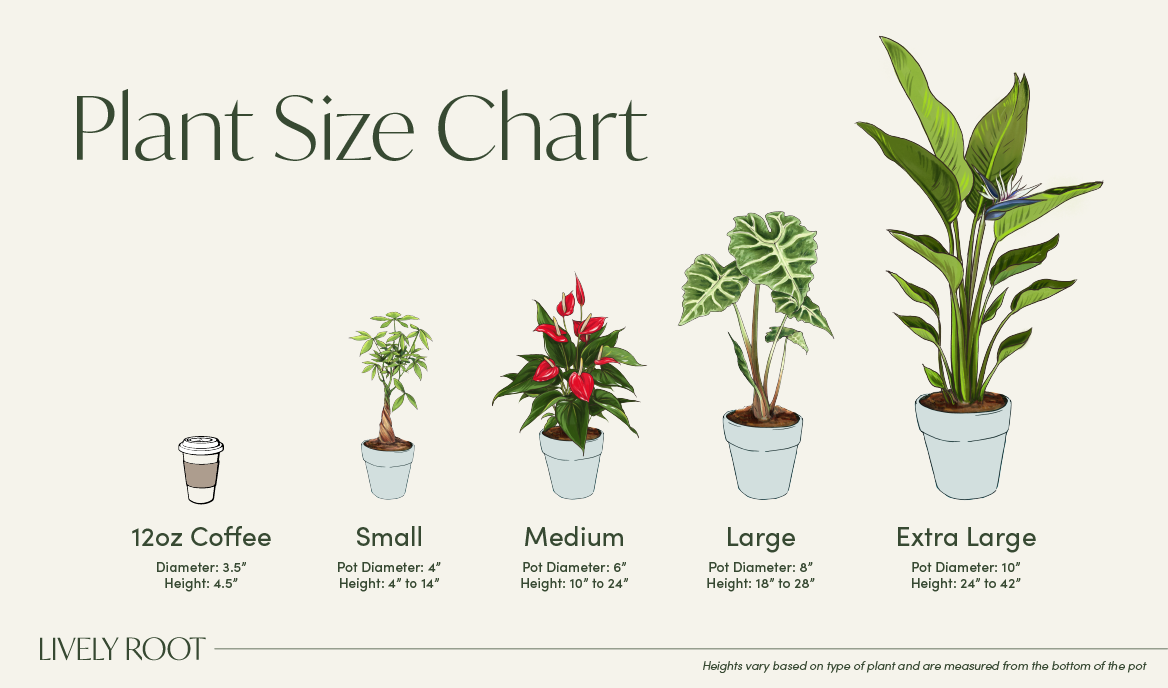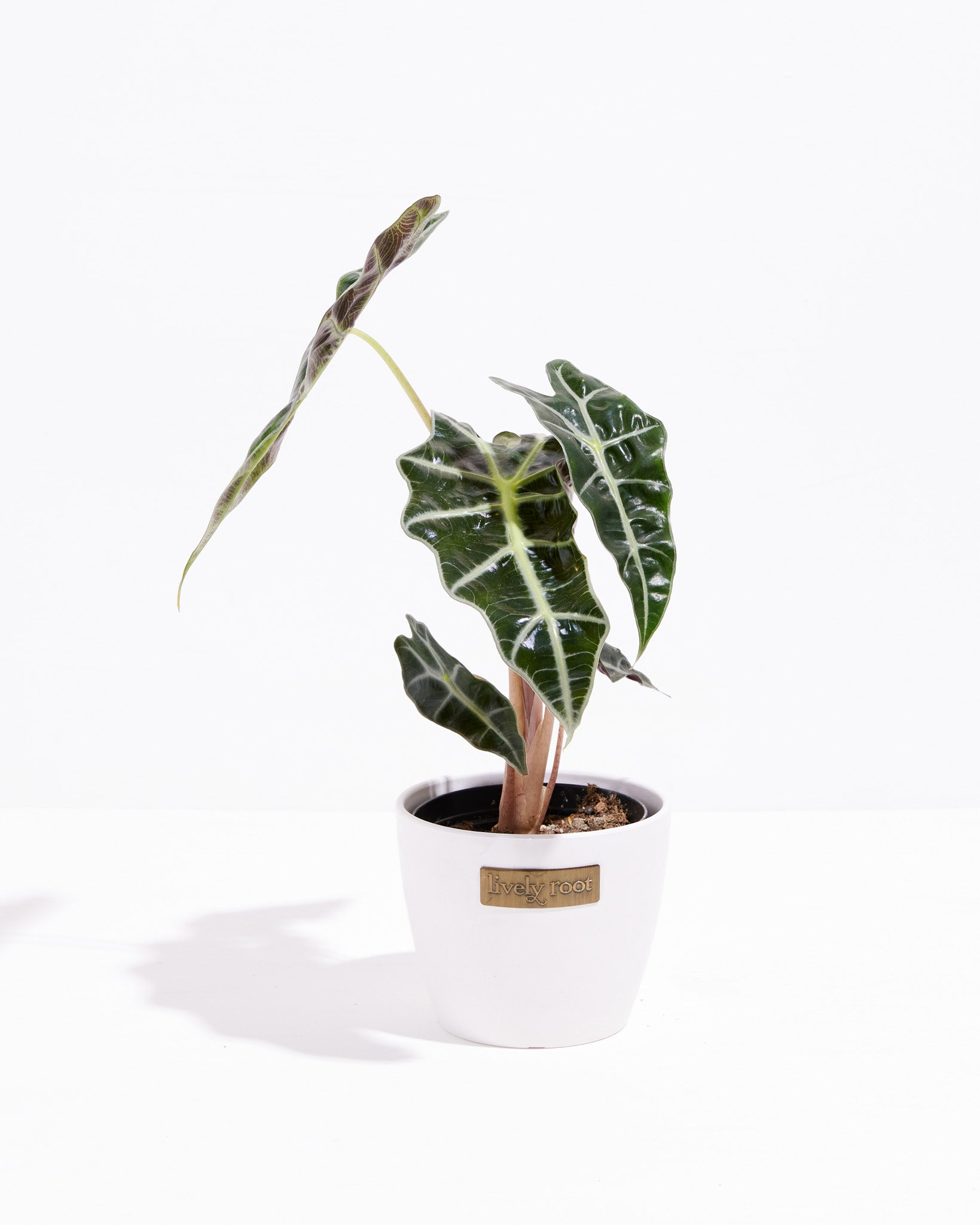

Alocasia Bambino Care Guide & Presentation

Alocasia's need bright, indirect light to keep their leaves a deep green.
Use unsoftened, filtered, bottled, or tap water sitting 24 hours to release the chemicals and water enough to discharge the drainage holes. Once the water is fully drained, replace it into the cache or decorative pot. Keep the plant's soil registering at 4-5 on the moisture meter. This plant doesn't do well under drought condition, so ensure the soil is always kept moderately moist.
Add humidity by adding a pebble tray filled with water, grouping with other plants or using a humidifier. Refrain from misting or getting water on the leaves as this may cause plant diseases.
Alocasia's prefer a warm, humid temperatures between 60-80°F. They will go into dormancy if the temperature goes below 60°F.
Outdoors part shade in morning sun (4-6 hrs.) where nights are above 60°F. Indoors in bright indirect sun areas. When bringing indoors, cut back by 1/3 to overwinter.
Outside: Alocasias need a slow-release fertilizer added to the soil and replenished every two to four weeks during the growing season. In the fall and winter months, back off to once per month in tropical locations. Inside: When watering, add a water-soluble fertilizer at half strength to maintain their heavy feeding requirements during the growing season. Cut back on this regimen in the fall and winter months while they rest.
When you're ready to repot, select a container with a drainage hole and 2" larger in diameter and height. Place a piece of screening at the bottom of the container over the drainage hole to secure the soil and allow it to drain. Use an indoor container mix that is well-draining. Add soil to the bottom of the container. Place the plant in the center. Ensure that the top level of the soil is a 1/2 inch below the pot's top edge to discourage spillover when watering. Backfill around the edges and pack lightly down to eliminate any air bubbles. Water well to dampen the soil and let it drain.
Gently wipe clean with a soft damp cloth or paper towel. Work gently from the base of the stem toward the tip of the leaf doing both sides at once. After cleaning the leaves, remove any dead leaves or debris on the surface of the soil. Do not mist this plant as it will encourage plant diseases. Refreshen the soil mixture if needed. Prune away damaged or diseased leaves down to the stem base with sterile scissors. It can be pruned down to a manageable size if overgrown.
Indoors: Propagate and divide alocasia in the early spring when emerging from dormancy. Pull from the container and brush or wash away the soil carefully. Carefully divide tubers apart and repot in a rich, indoor potting soil mix. Outdoors: Carefully loosen the soil and dig the tubers up, avoiding damaging the tubers. Divide the tubers and plant in new locations in your garden. Add rich, damp, and loamy soil in a part-shade morning sun location. Plant three feet apart if grouping together. Place the tubers at the depth they were in the ground before. Water the soil and tuber well before covering with soil. Add topsoil and water slightly to dampen. Keep the soil moist but not soggy.
Alocasia Amazonica Bambino: Overview
Alocasia Amazonica Bambino, commonly known as the Elephant Ear or African Mask Plant, is a striking houseplant with dark green, narrow, arrowhead-shaped leaves and prominent white veins. This compact version of the larger Alocasia Amazonica Polly features glossy, elongated foliage that gives it an elegant, exotic appearance. Belonging to the Araceae family, it originates from tropical Southeast Asian regions and thrives in USDA hardiness zones 10-12.
Alocasia Bambino prefers bright, indirect light and is sensitive to direct sunlight, making it a suitable indoor plant. Its care level is considered moderate, requiring a careful balance of humidity and moisture. The Alocasia plant symbolizes strength and adaptability, with its bold leaves often associated with resilience and courage. However, this plant is toxic to pets and should be kept out of reach of cats, dogs, and small children.
Also notable is the Variegated Alocasia Frydek, known for its striking white and green variegated leaves, which add a unique touch to any plant collection.
Alocasia: Benefits
- It purifies indoor air, removing toxins
- A striking plant with high aesthetic appeal
- It reduces stress and promotes relaxation
- A unique and thoughtful gift plant
- Adds a tropical and exotic vibe to any space
Alocasia Bambino: Care Guide
Alocasia Bambino is a moderately easy-care plant that thrives in bright, indirect light with proper watering and humidity. Here's how to care for this striking Elephant Ear plant:
Watering & Soil
Water your Alocasia Bambino when the top inch of the soil feels dry, but avoid letting the soil dry out completely. To prevent root rot, provide well-draining soil with good aeration, such as a peat-based mix.
Light & Temperature
Alocasia Bambino thrives in bright, indirect light but can tolerate lower light conditions. However, it should be kept out of direct sunlight, which can scorch its leaves. The plant does best in temperatures between 60°F and 80°F and should be protected from drafts or cold.
Humidity & Feeding
This plant enjoys higher humidity levels, so misting the leaves or using a humidifier can keep it happy. To promote healthy growth, feed your Alocasia with a balanced liquid fertilizer every 4-6 weeks during the growing season (spring and summer).
Repotting & Propagation
Repot the Alocasia every 1-2 years in fresh soil to provide room for its roots. When repotting, you can propagate the plant through division by carefully separating the offsets and planting them in new pots.
Pruning, Cleaning & Common Issues
Prune away any yellowing or dead leaves to encourage new growth. Wipe the leaves regularly to remove dust and keep them looking fresh. Common issues include overwatering, which can lead to root rot, and pests like spider mites or aphids.
Variegated Alocasia Bambino: Placement, Companion & Alternative Plants
Alocasia Bambino’s compact size and unique foliage make it a stunning addition to any interior. Its bold appearance adds an exotic touch to living spaces. Due to its specific needs, this plant is best suited for those with some plant care experience.
Best Locations & Uses
- Perfect for compact spaces, as it’s small in size.
- A beautiful accent plant for living rooms or bedrooms with bright, indirect light.
- Ideal for experienced plant enthusiasts.
- It's best for homes without pets, as it’s toxic if ingested.
- Great for tropical-themed decor or adding an exotic vibe to any room, including offices.
Companion Plants
Alocasia Variegated Bambino pairs well with plants that thrive in similar conditions, adding diverse textures and colors to your indoor space.
- Philodendron Cordatum (Philodendron cordatum ‘Green’): Philodendron Cordatum is a trailing plant with heart-shaped variegated leaves that complements the upright growth of AlocasiaAmazonica Bambino, ideal for bright, indirect light.
- Japanese Bird’s Nest Fern (Asplenium antiquum): The Japanese Bird’s Nest Fern is a pet-friendly fern that brings lush greenery and thrives in medium to low-light conditions like the Bambinoy plant.
- Peacock Plant (Calathea roseopicta): The Peacock Plant is known for its striking foliage; this pet-friendly plant pairs well with AlocasiaAmazonica Variegated, sharing a love for humid environments and indirect light.
Alternative Plants
If you’re looking for pet-friendly alternatives to Bambino Alocasia, consider these beautiful and easy-care options, available on Lively Root.
- Calathea Makoyana “Cathedral Windows” (Goeppertia makoyana (syn. Calathea makoyana): Calathea Makoyana Cathedral Windows is a stunning pet-safe plant with broad, colorful leaves and excellent air-purifying qualities.
- Peperomia Ginny (Peperomia clusiifolia ‘Ginny’): Peperomia Ginny is a compact, low-maintenance plant with variegated pink and green leaves, perfect for tabletops and small spaces.
- Hindu Hoya Rope Plant (Hoya carnosa 'Compacta'): The Hoya Rope Plant is a unique, trailing plant known for its twisted foliage and low water requirements.
Add the Beautiful Alocasia Bambino Variegated to Your Collection Now
Add the striking Alocasia Bambino to your collection today and elevate your space with its unique beauty. It is perfect for plant enthusiasts looking for a bold, elegant statement piece.
























